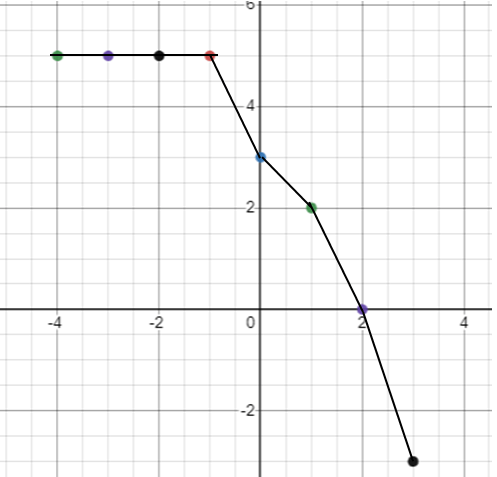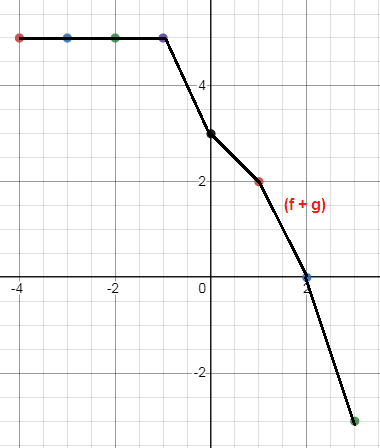ADDING SUBTRACTING MULTIPLYING AND DIVIDING FUNCTIONS FROM GRAPH
To add, subtract, multiply or divide two functions from graph, we have to perform the same arithmetic operation with the outputs of the function f(x) and g(x). Let us see this briefly.
Let the given functions as f(x) and g(x).
Adding functions :
(f + g)(x) = f(x) + g(x)
Let (x, a) and (x, b) be the coordinates in the function f(x) and g(x) respectively. To add these two functions, we follow the rule following.
(f + g)(x) ==> (x, a + b)
Subtracting functions :
(f - g)(x) = f(x) - g(x)
Let (x, a) and (x, b) be the coordinates in the function f(x) and g(x) respectively. To subtract these two functions, we follow the rule following.
(f - g)(x) ==> (x, a - b)
Multiplying functions :
(f ⋅ g)(x) = f(x) ⋅ g(x)
Let (x, a) and (x, b) be the coordinates in the function f(x) and g(x) respectively. To multiply these two functions, we follow the rule following.
(f ⋅ g)(x) ==> (x, a ⋅ b)
Dividing functions :
(f / g)(x) = f(x) / g(x)
Let (x, a) and (x, b) be the coordinates in the function f(x) and g(x) respectively. To multiply these two functions, we follow the rule following.
(f / g)(x) ==> (x, a / b)
Use the graphs of f and g to evaluate the functions.

Problem 1 :
a) (f + g)(3) b) (f/g)(2)
Solution:
(f + g)(3) = f(3) + g(3)
= 2 + 1
(f + g)(3) = 3
b) (f/g)(2)
Solution:
(f/g)(2) = f(2)/g(2)
= 0/2
(f/g)(2) = 0
Problem 2 :
a) (f - g)(1) b) (fg)(4)
Solution:
(f - g)(1) = f(1) - g(1)
= 2 - 3
(f - g)(1) = -1
b) (fg)(4)
Solution:
(fg)(4) = f(4) ⋅ g(4)
= 4 ⋅ 0
(fg)(4) = 0
Problem 3 :
a) (f ∘ g)(2) b) (g ∘ f)(2)
Solution:
(f ∘ g)(2) = f[g(2)]
= f(2)
(f ∘ g)(2) = 0
b) (g ∘ f)(2)
Solution:
(g ∘ f)(2) = g[f(2)]
= g(0)
(g ∘ f)(2) = 4
Problem 4 :
a) (f ∘ g)(1) b) (g ∘ f)(3)
Solution:
(f ∘ g)(1) = f[g(1)]
= f(3)
(f ∘ g)(1) = 2
b) (g ∘ f)(3)
Solution:
(g ∘ f)(3) = g[f(3)]
= g(2)
(g ∘ f)(3) = 2
Use the graphs of f and g to solve.

Problem 5 :
Find (f + g)(-3)
Solution:
(f + g)(-3) = f(-3) + g(-3)
= 4 + 1
= 5
Problem 6 :
Find (g - f)(-2).
Solution:
(g - f)(-2) = g(-2) - f(-2)
= 2 - 3
= -1
Problem 7 :
Find (fg)(2)
Solution:
(fg)(2) = f(2) ⋅ g(2)
= -1 ⋅ 1
= -1
Problem 8 :
Find (g/f)(3)
Solution:
(g/f)(3) = g(3)/f(3)
= 0/-3
= 0
Problem 9 :
Draw the graph of of f + g and find domain and range.
Solution:

So, the domain of (f + g) is (-4, 3).
Problem 10 :
Find the domain of f/g.
Solution:
|
x -5 -4 -3 -2 -1 0 1 2 3 4 5 |
f(x) undefined 5 4 3 2 2 1 -1 -3 undefined undefined |
g(x) -1 0 1 2 2 1 1 1 0 -1 -2 |
f/g undefined undefined 4 1.5 1.5 2 1 -1 undefined undefined undefined |
So, the domain of (f/g) is (-3, 2).
Problem 11 :
Graph f + g.
Solution:
|
x -5 -4 -3 -2 -1 0 1 2 3 4 5 |
f(x) undefined 5 4 3 2 2 1 -1 -3 undefined undefined |
g(x) -1 0 1 2 2 1 1 1 0 -1 -2 |
f+g undefined 5 5 5 4 3 2 0 -3 undefined undefined |

Problem 12 :
Graph f - g.
Solution:
|
x -5 -4 -3 -2 -1 0 1 2 3 4 5 |
f(x) undefined 5 4 3 2 2 1 -1 -3 undefined undefined |
g(x) -1 0 1 2 2 1 1 1 0 -1 -2 |
f-g undefined 5 3 1 0 1 0 -2 -3 undefined undefined |

Recent Articles
-
Finding Range of Values Inequality Problems
May 21, 24 08:51 PM
Finding Range of Values Inequality Problems -
Solving Two Step Inequality Word Problems
May 21, 24 08:51 AM
Solving Two Step Inequality Word Problems -
Exponential Function Context and Data Modeling
May 20, 24 10:45 PM
Exponential Function Context and Data Modeling